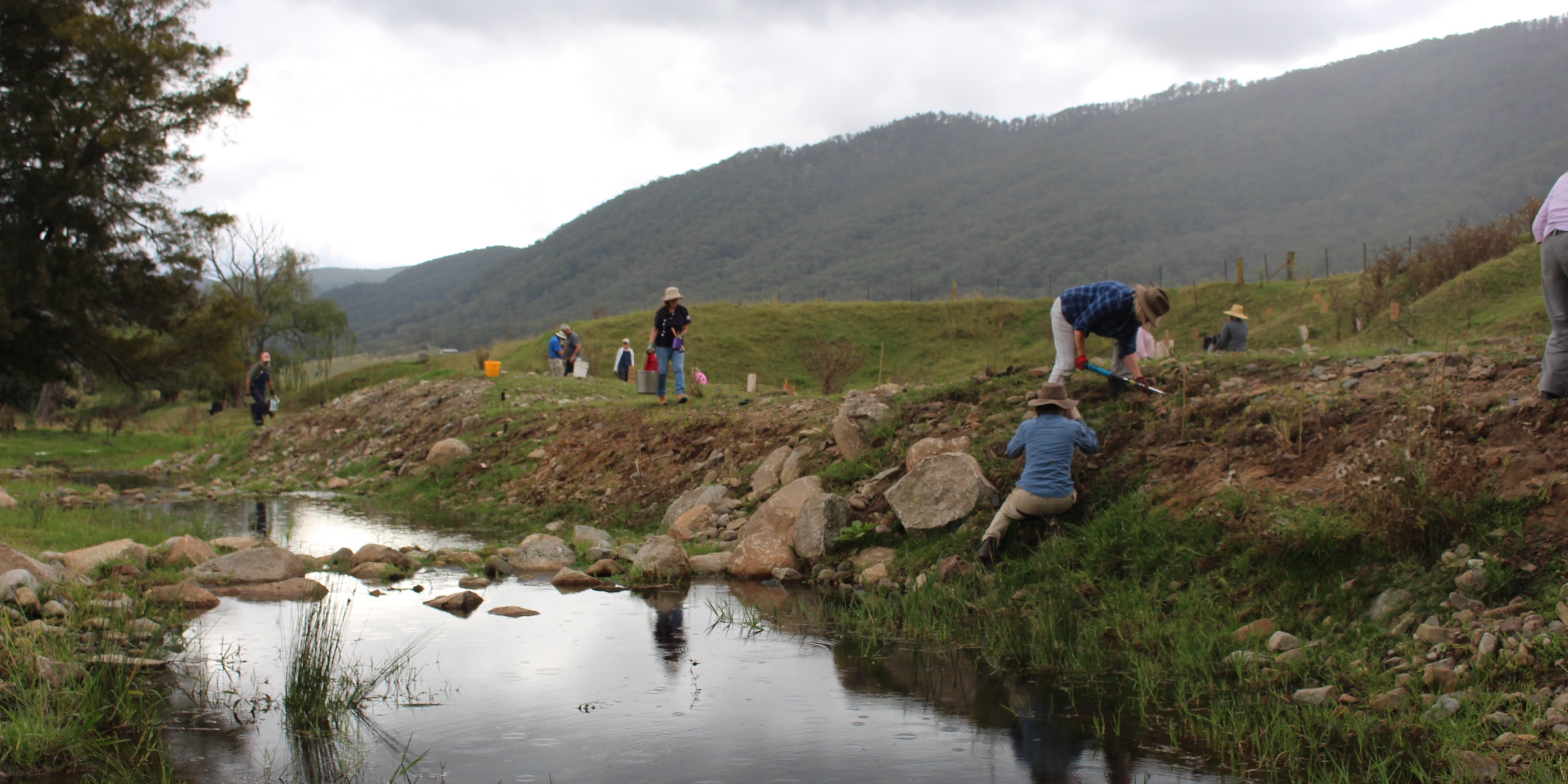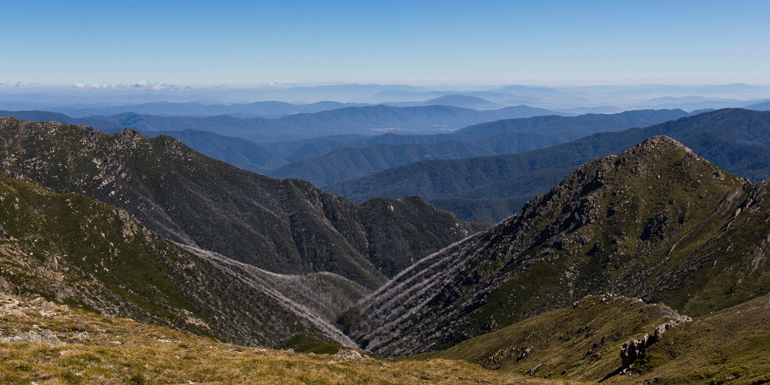Key points
- Our alpine region supports unique ecosystems and key species, which are specially adapted to living in these conditions.
- The region contains important industries in agriculture, forestry, renewable energy and tourism, with a large winter tourism season attracting people from across Australia and the world.
- Our alpine region is vulnerable to climate change, particularly to increased temperatures which will impact the snow cover that many ecosystems, species and industries rely on.
- Regional climate projections show that the alpine region is likely to continue warming and become drier. Winter temperatures are projected to rise by more than 2°C in the far future.
- Understanding the impacts of climate change on our alpine region helps us better manage this region now and under changing conditions.
The importance of the alpine region in NSW
The NSW and Australian Capital Territory Alpine region is the highest mountain range in Australia, containing Australia's only peaks of more than 2,000 metres above sea level. It is home to important ecosystems and is Australia’s most popular snow holiday destination.
The alpine landscape and climate support unique ecosystems and many endemic species. Some alpine species need a certain amount of snow cover for their habitats, such as the endangered mountain pygmy possum (Burramys parvus).
The region contributes to regional employment and the NSW economy through key industries including tourism, energy generation and agriculture and forestry.
Some of the largest ski resorts in the southern hemisphere and a variety of small tourism businesses can be found here. Winter is the major tourism season for the region, with activities based around snow sports. Year-round tourism industries include recreational fishing, hiking, kayaking, mountain biking and educational and cultural experiences.
The Snowy Hydro Electric Scheme generates electricity by collecting and diverting water from rainfall and snowmelt in the region. This scheme provides employment opportunities across the alpine region and surrounding areas, and has been providing renewable energy for almost 70 years.
Primary industries in the region include animal agriculture, forestry, and cold climate crops such as apples and berries. The region also plays an important role in the wider NSW agriculture industry, with snowmelt and rainfall run-off contributing to the Murrumbidgee and Murray rivers for irrigation.
Changes to the climate of NSW’s alpine region are expected to impact its ecosystems, people and industries.
How our alpine region is affected by climate change in NSW
The alpine region of NSW and the ACT is already experiencing the impacts of climate change, particularly through warmer temperatures and less rainfall.
Our alpine region is likely to continue warming and become drier. Winter temperatures are projected to rise by more than 2°C in the far future. Spring rainfall is projected to decrease by 20% in the far future.
These changes will affect alpine ecosystems, businesses and industries, through changes to:
Climate change affects water availability through increased temperatures and changes to rainfall patterns. These changes impact the quantity of both surface water and groundwater.
Projections show that the alpine region is likely to experience a reduction in surface-water run-off in future. For areas of the region that are at higher elevations, a reduction of more than 40 mm/year is projected in the far future (2060–2079).
The amount of water absorbed into groundwater reserves (groundwater recharge) is projected to decrease in the alpine region in both the near and far future.
Climate change is projected to affect the depth of snow in our alpine region, through increased temperatures and fewer cold days. While some artificial snowmaking techniques can increase snow cover, increased temperatures are projected to reduce suitable snowmaking conditions by 20% in the near future (2020–2039), and between 50 and 60% in the far future (2060–2079). Reduced snow cover will impact the region’s winter tourism season.
Bushfire can cause significant damage and loss to human life and infrastructure.
Fire weather is projected to increase in winter and spring and decrease during summer, and this pattern is expected to continue into the future.
Rainfall and snowmelt are natural causes of erosion in the alpine region. More severe storms and extreme rainfall events can increase erosion. Climate change is projected to increase storms and rainfall events, which will impact erosion in the region.
Projections for soil erosivity (the potential for soil to be eroded by rain) and hillslope erosion in the NSW alpine region show an increase by 2–8% in the near future (2020–2039), and 8–18% in the far future (2060–2079).
Increased erosion impacts natural ecosystems, agricultural land and the water quality of the region.
Alpine regions support a range of cold-climate crop industries including as apples and berries. The alpine region indirectly supports crop industries downstream in the Murray–Riverina region, with snowmelt and rainfall run-off contributing to the Murrumbidgee and Murray rivers.
Future climate change is projected to impact crops through:
- increased temperatures changing the conditions that suit cold-climate crops
- changes to rainfall patterns in the alpine region
- changes to downstream water availability as a result of changes to alpine rainfall run-off and snow melt.
Alpine flora and fauna have adapted to fit a small window of ecological conditions, making them sensitive to changes in the climate. Changes in climate will affect key alpine habitats such as grassy woodlands and montane lakes, bogs and fens.
Changing conditions will place more stress on already threatened species. Vegetation communities are projected to experience 21–70% change in species composition in the far future (2060 to 2079).
Adapting to changes in the alpine region of NSW
The most effective way of limiting the impacts of climate change on our alpine region is to reduce carbon emissions and thus the atmospheric warming. However, some level of impact, particularly from increased temperatures, is still expected to occur.
Adapting to the impacts of climate change in the alpine region requires an understanding of the region’s features and values, including:
- biophysical features, such as the region’s ecology, soil and hydrology
- cultural values
- economic importance, including key industries
- social factors such as the health and wellbeing of residents and tourists.
The Australian Government’s Multi-Criteria Analysis Shell for Spatial Decision Support (MCAS-S) tool was used to bring together different types of information on NSW’s alpine region. This work provides important data for the management of NSW’s alpine region under changing conditions.
Other actions being taken to help the region adapt to climate change include:
- the NSW Government’s Kosciuszko National Park Amendment to Plan of Management, which supports year-round tourism in the alpine national park
- the NSW Government’s South East and Tablelands Regional Plan 2036, which aims to increase year-round tourism and protect key natural environments including alpine regions
- climate change adaptation strategies in the alpine tourism sector
- climate change projections and data into management plans and strategies, such as NSW Government’s Regional water strategies
- managing landscapes to increase the ability of ecosystems to adapt to climate change
- managing non-climate risks, such as invasive species, to ease pressures on threatened species
- considering climate risks in local government planning.
Related information
Snowy Mountains Special Activation Precinct – NSW Government
South East and Tablelands Regional Plan 2036 – NSW Government
Managing changing landscapes – Macquarie University
Kosciuszko National Park Amendment to Plan of Management – NSW Government
Case studies

The Yass Area Network of Landcare Groups is is using the Restore and Renew webtool to guide seed selection for their Climate Ready Revegetation Project.


When a local risk research firm began work on the ‘Blueprint for a Resilient South-East NSW’ project, they turned to NARCliM to get the data they needed to develop a comprehensive picture of regional climate risk.
